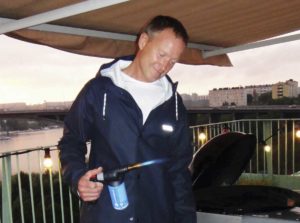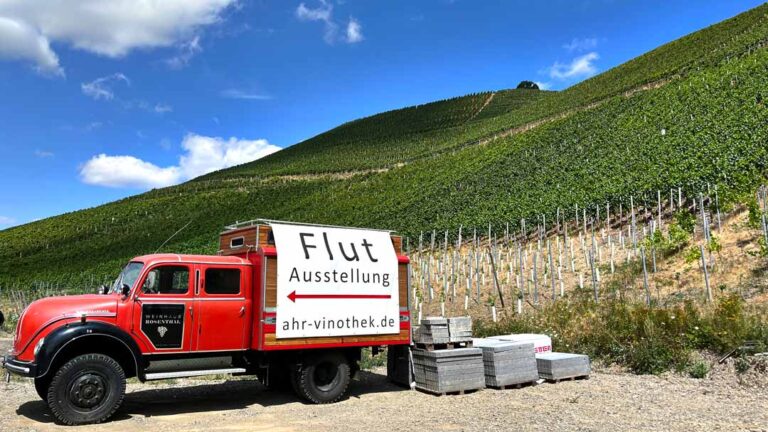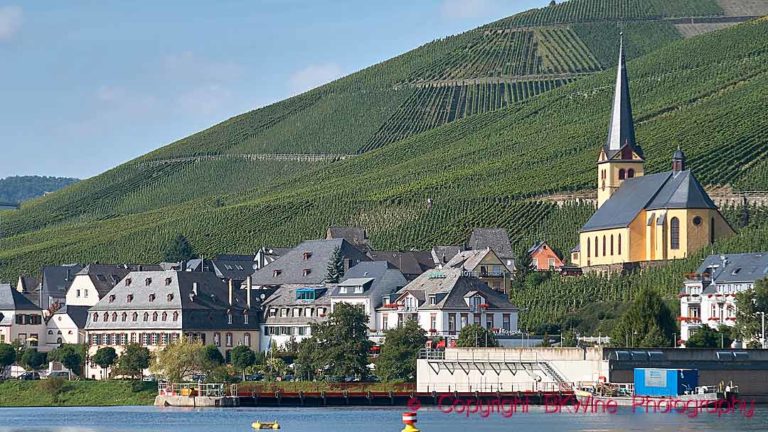Secateur or spraying plane?
Early morning in July 2019. A pre-arranged schedule involves alarm clock and strong coffee to have the time to go on a bike morning session. On a mountain-bike, Mosel’s makes it a playful educational ride to exhaust the body. Very hilly and with innumerable trails and passes to follow. That the end happened to be in a vineyard under a spraying helicopter that dumped a fog of benign drops was somewhat unexpected. The impression was even stronger after the afternoon meeting with a winemaker whose chief weapon was small secateurs.
Each wine region has its own great vintages. For Mosel, the last exceptional vintage was 2015, although ‘16 and ‘17 overall showed good results. 2018 presented some “excitement” for the producers in the Mosel as early as mid-April when some growers woke up to a snow cover on their vines. Thankfully not too much and quite brief, without causing harm. During the summer, the heat and drought were on everyone’s lips but it also passed without major damage. After an enriching rain in September 2018, one of the largest volumes in many years of riesling was harvested. Add to that a quality that was top notch and we have a lot of producers cheering. The visit to the Mosel this time was a mixture of quick drop-in tastings of the 2018s and a few more in-depth visits.
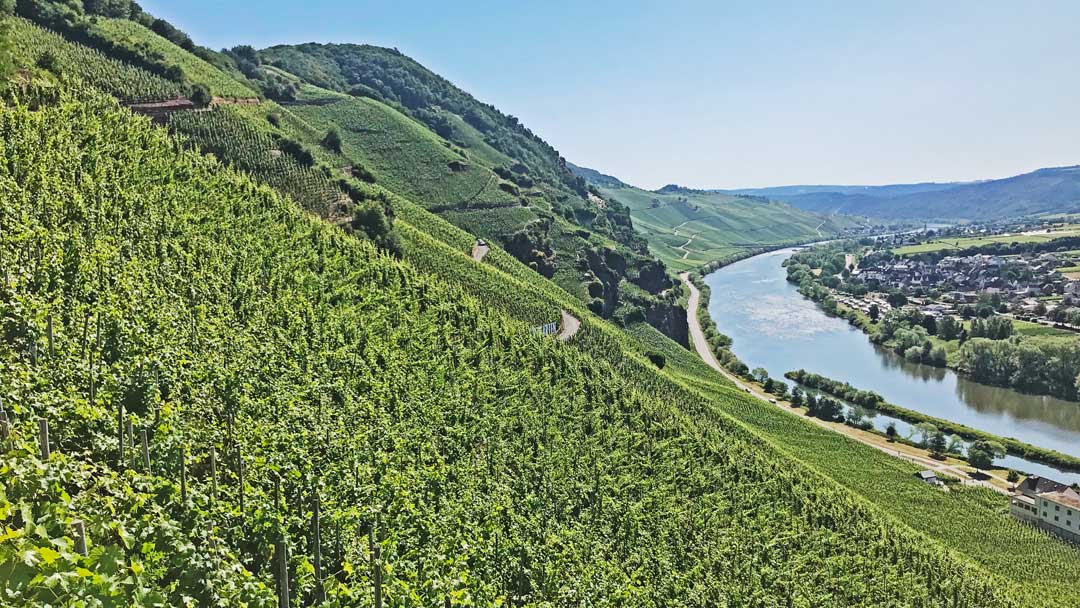
At Zilliken in Saarburg in the southern part of the Mosel, Ruth Zilliken received and generously served everything that was asked for. Not entirely unexpectedly, all of their wines in different quality levels hold an even and high standard. 2018 Rausch Auslese was the glass that was hardest to put down. But the lasting impression is how close in taste they are to each other, the young wines we tasted. Before each wine reaches its maturity, many of the aromas, details and taste impressions that will surely develop and distinguish entry-level wines from prestige wines in a few years are missing.
Here at Ziliken I got the same impression as at Dr Loosen, Haart and other producers. The wines are young, eager and shout in line after being put down in the cellar. Some may say that ageing is about taste and preferences, but no Sir that is not correct. The higher echelons are of course made with exacting standards, but have yet to develop the range of nuances that ageing brings.
Zilliken is part of the VDP that presents wines from Gutswein up to Grosse Lage, from cheap-and-nice to more expensive and outstanding, where the dry versions of the top group often is called GG, Grosse Gewächs. GG was, however, out of reach since GG 2018 will not go on sale until September, but we tried some of the other Prädikat under the heading Grosse Lage. Do buy 2018 but to pull cork of the top wines already today is to miss an opportunity for greatness. But with all due respect, feel free to miss an opportunity or two already now if you feel like it.
In terms of quality, there were insanely good wines from most producers even in the second highest class, Erste Lage, which in terms of price gives you significantly more bottles for the same money and also with a lot of ageing potential. With the exception of some vineyard locations, a slightly higher harvest yield is allowed in the Erste Lage than the Grosse Lage. 60 and 50 hectolitres per hectare respectively.
But I have to come back to the spraying, or the helicopter, which sprayed the vines belonging to one of the more renowned VDP producers. I actually checked the name tag on the posts to find out who was the owner. My own body rid itself of any spray later on in the shower, but one can’t help but wonder how much of what is being sprayed will also end up in the glass you hold in your hand. If you buy a small candy, every ingredient is listed on the packaging but on a bottle of wine there is absolutely nothing.
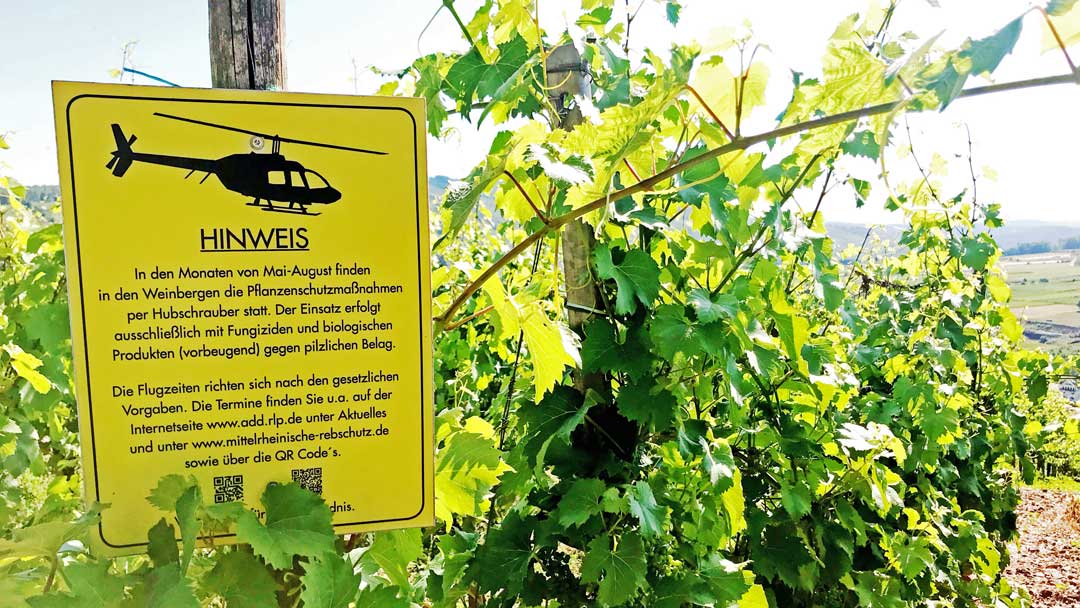
With the above in fresh memory, Sybille Kuntz is in stark contrast. I meet her and her husband Markus at one of their most recently purchased vineyard plots. They have purposefully aimed at acquiring the steepest parcels in the Mosel valley, despite all the extra work it for maintenance and harvesting. Today they own 18 hectares and the question of how big they want to be is given the noncommittal answer “It’s an organic process”.
They have been growing biodynamically since 2011, giving them a completely different arsenal to fight attacks in the crops than a helicopter. One can have different views of biodynamics, but I sincerely believe in the long-term effect of it. On site in the vineyard, we went through how the vines coped with the heat, or did not cope, since a number of the young plants had died and will need to be replanted. We talked about their view of ploughing between the rows instead of spraying against the weeds. The importance of canopy management and pruning to keep harvest yields down.
You do not need any training to see the difference in the winery’s efforts. The rows of the different owners are within a few meters and although it is the same grape that is grown, the appearances of the vines differ and the soil between them is distinctly different. Sybille Kuntz is not affiliated with VDP, nor is Georg Breuer, Markus Molitor and a number of other top producers in Germany. How much should be attributed to the biodynamics is something that I can’t speculate on, but the vines have been allowed to fight on without artificial help.
It was here that the winner of the Mosel visit was found. Sybille Kuntz 2018 Kabinett Trocken has a light, grape-typical nose without petroleum tones. More power than just apples and citrus. The mouthfeel, more than the taste, is tight, with high, but not bitter acidity. Possibly some bitterness like from the skin on a grapefruit. A food wine full of nuances more than an easy glass on the terrace. The wine is on the market but is not on their website yet. Maybe they are busy replacing the helicopter job with small secateurs. And yes, it will also win on ageing.
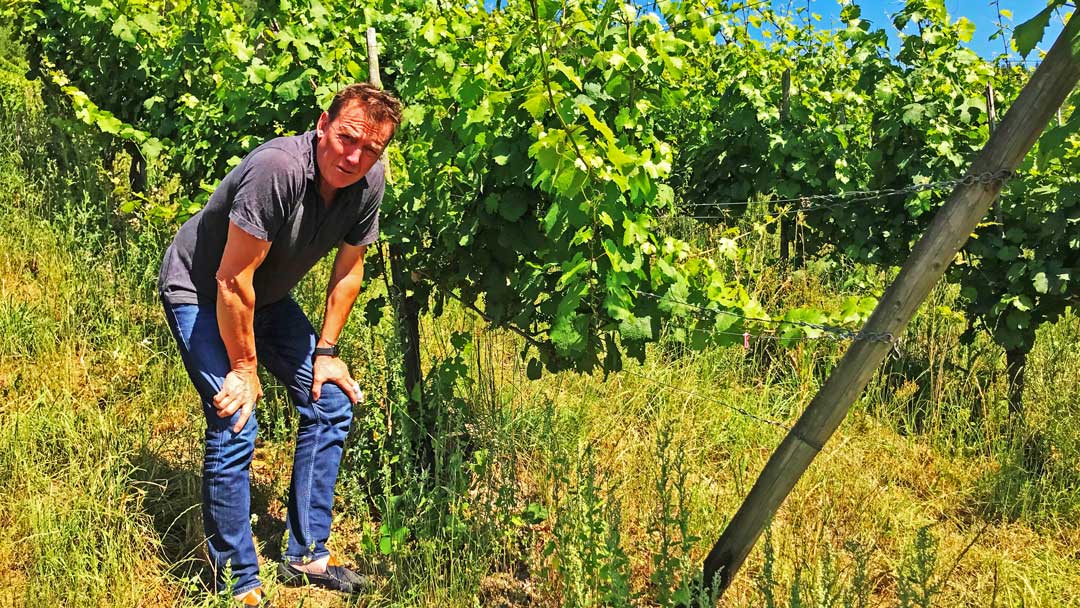
The number of wineries that are certified Demeter (biodynamic) has doubled since 2001. Of Germany’s wine producers, only about 60 winemakers are certified Demeter and one is certified Biodyvin (another biodynamic certification), Bürklin Wolf. I want to underline once again that I stand to the side of the debate on biodynamic cultivation. But given the fact that it is still permitted to fight weed with Roundup, you have to admit that it is worth a thought. Admittedly, Roundup lost its patent in 2000 and the substance glyphosate is now produced by several manufacturers under different names. A ban is under discussion, but the EU process is slow. For us consumers, it is an almost impossible task to keep track of all producers and whether they spray and use additives. Sure, a number of brands you can keep track of, but overall there may be a benefit in quality labels such as Demeter, Biodyvin or similar for biodynamic or organic cultivation. Europe has a pretty easy-to-understand certification, but if you look at the rest of the world it is not so easy. The burden thus rests on your shoulders if you want to know what you are buying. [Ed: See the comment below, however.]
Overall, the impressions from the visits and the wines are that it is a good idea to spend a big part of your piggybank money on some cases of 2018. My assessment is (please leave a comment if you think I am wrong) that the quality is already there in the mid-price segment. It is always possible to line up superlatives about the most expensive vineyard locations, but unfortunately it is not for everyone’s wallet and thus falls some of the benefit of the insight on what is good at those prices. Unfortunately, some wines in the lower price ranges showed a slightly low acidity in relation to the fine fruit. 2018 is not a 100% solution for top wines from all producers. That the text above came to be coloured by the philosophy of the production was probably a coincidence. But given the trend on sustainability today, I guess more and more people will actually be concerned about the producers’ way of cultivation.
Sven-Olof Johansson is a wine enthusiast in Stockholm with a long history of wine tasting experiences.
[Ed 1: Glyphosate is a much-debated substance. Many scientific studies conclude that, used properly, it is not dangerous. Others believe that it is potentially carcinogenic (which also coffee is considered to be). Read a brief note about glyphosate here. The EU has extended the permit, but the debate will certainly be reopened.]
[Ed 2: As mentioned in the text, organic certification is homogeneous and identical in all EU countries. Most of the rest of the world does not have their own definitions of ‘organic’ and in practice they use the European (EU) definition of organic. One of the reasons for this is that if they want to be able to sell their wine in the EU with the designation “organic” then they must follow the rules that apply within the EU. So in practice, it’s easy; if you buy a wine that says “organic” on the label then it follows the rules defined by the EU. (What will happen in the UK after Brexit is another question perhaps.) The exception is the United States, which has its own definition of organic that is different, but there is also a bilateral agreement with the EU. If you want to know more about organic and biodynamic you can read the book Biodynamic, Organic and Natural Winemaking; Sustainable Viticulture and Viniculture. ]


